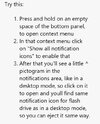Hi there,
I recently transferred (or tried to transfer) some files from my laptop to my wife's (Lenovo) tablet using a previously unused 8 GB Kingston "DataTraveller" memory stick
Transferring the initial batch of files worked fine, but the memory stick then 'stopped working' to the extent that neither laptop nor tablet even acknowledge its existence when it is plugged in. I therefore tried to continue with a different (identical) memory stick. Again, the first batch of transfers worked fine but then, again, the memory stick 'died' in the same fashion as the first.
I have subsequently completed the exercise using a third memory stick, (again a Kingston DataTraveller, but much older, of a different style and previously used), which has survived the experience, and continues to work fine.
I've never experienced anything quite like this. Other than in the case of 'hardware failure', I've never known any sort of storage device to become invisible to a computer, such that it can't at least be re-formatted. I don't recall ever having used any USB device (other than the charger) with the tablet in the past, and if it were of a less reputable make, I might wonder whether a wildly incorrect voltage coming out of the USB socket might have done the harm.
I've perfectly happy to just throw the sticks into the bin, given that I have a 'drawer full' of such (cheap) things, but I'm rather intrigued to know what could have resulted in what I experienced (and, I suppose, whether it is a 'recoverable' situation).
Any thoughts/ideas?
Kind Regards, John
I recently transferred (or tried to transfer) some files from my laptop to my wife's (Lenovo) tablet using a previously unused 8 GB Kingston "DataTraveller" memory stick
Transferring the initial batch of files worked fine, but the memory stick then 'stopped working' to the extent that neither laptop nor tablet even acknowledge its existence when it is plugged in. I therefore tried to continue with a different (identical) memory stick. Again, the first batch of transfers worked fine but then, again, the memory stick 'died' in the same fashion as the first.
I have subsequently completed the exercise using a third memory stick, (again a Kingston DataTraveller, but much older, of a different style and previously used), which has survived the experience, and continues to work fine.
I've never experienced anything quite like this. Other than in the case of 'hardware failure', I've never known any sort of storage device to become invisible to a computer, such that it can't at least be re-formatted. I don't recall ever having used any USB device (other than the charger) with the tablet in the past, and if it were of a less reputable make, I might wonder whether a wildly incorrect voltage coming out of the USB socket might have done the harm.
I've perfectly happy to just throw the sticks into the bin, given that I have a 'drawer full' of such (cheap) things, but I'm rather intrigued to know what could have resulted in what I experienced (and, I suppose, whether it is a 'recoverable' situation).
Any thoughts/ideas?
Kind Regards, John


